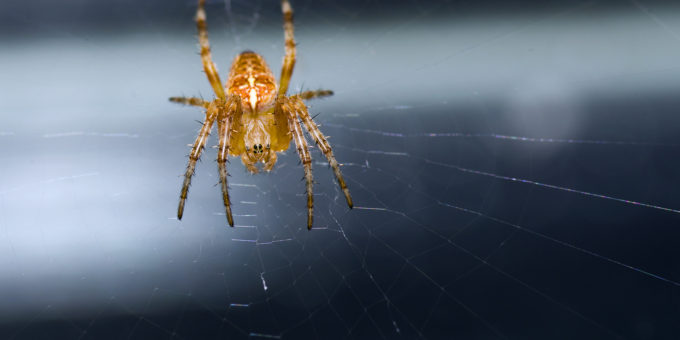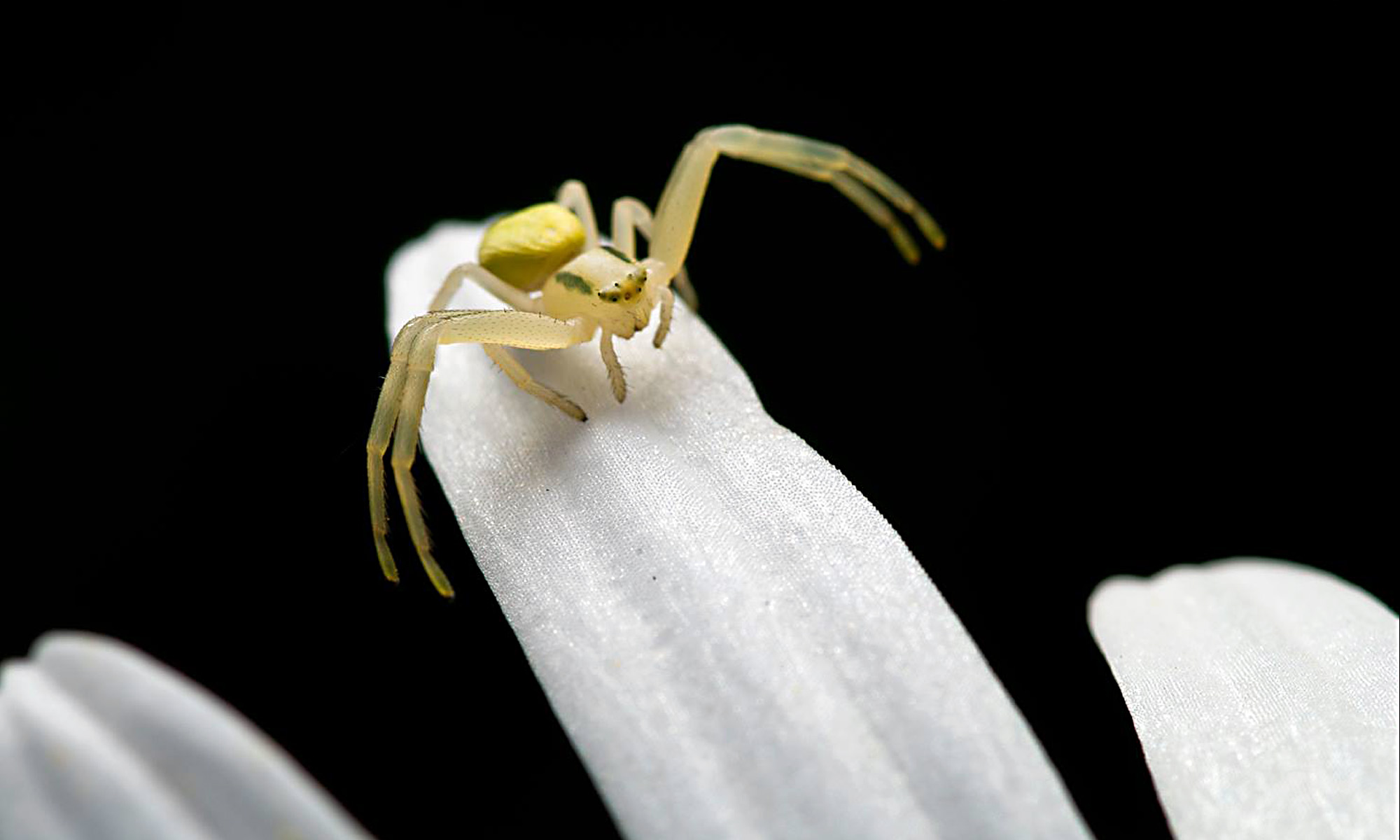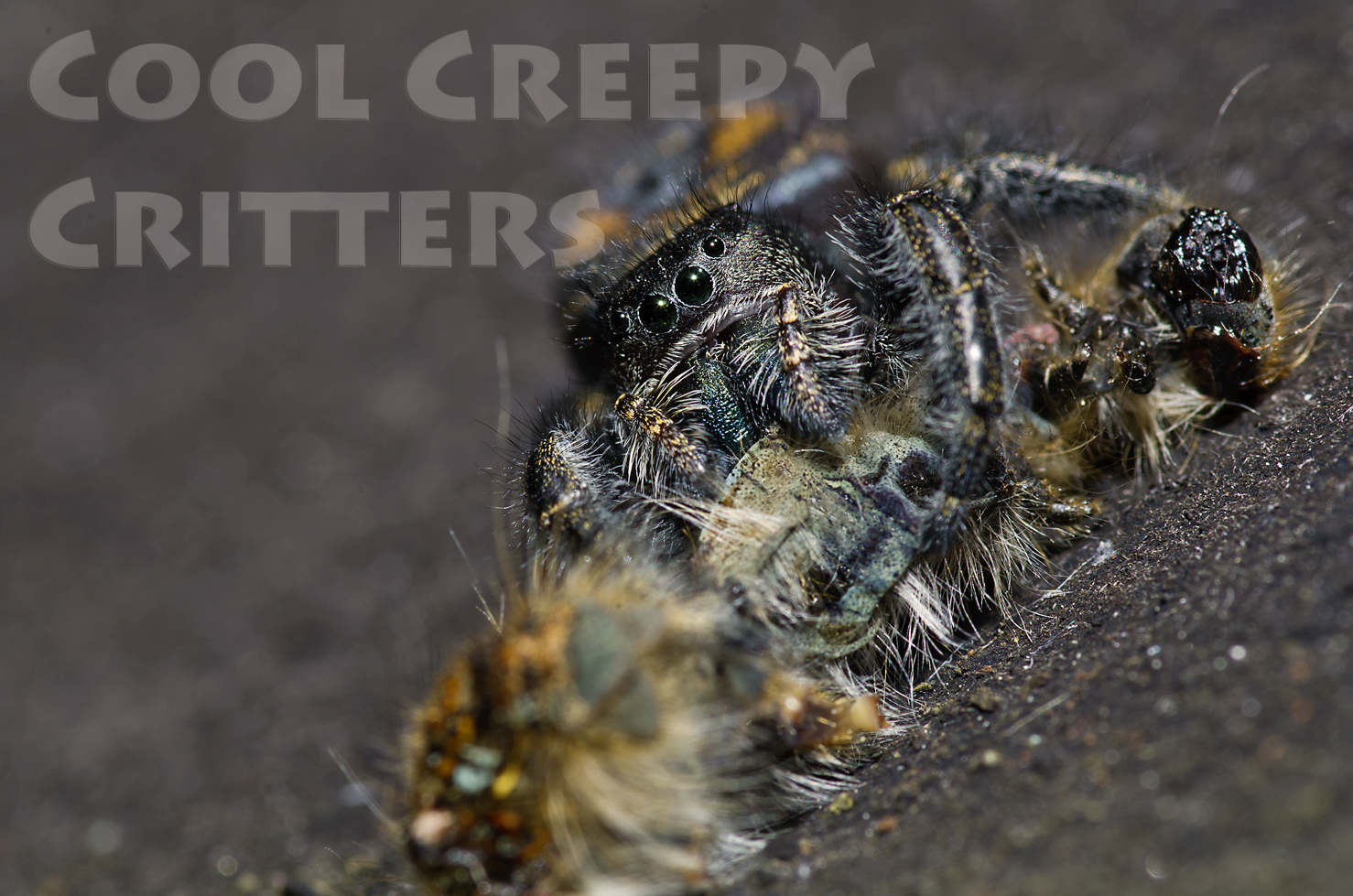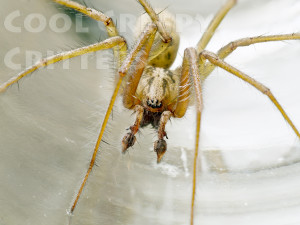Category: Arachnids
Garden full of Spiders – The Orb Weavers
Around this time of year the garden fills with these little Orb Weavers Araneus diadematus. These little spiders are first seen in the spring in little clusters of the tiny spiders holding together in a ball for survival. But as late August roles around these spiders start to get to their largest sizes and fill the yard and garden with their many webs.
Orb weavers come in many types but the ones I see in my yard are sometimes called European Garden spiders ( Also found in North America) or Cross spiders. This little Orb Weaver is harmless to people being docile and not interested in biting unless provoked. It is however a veracious predator in the garden consuming a large variety of insects throughout the spring summer and fall. August and September seem to be the months when the most variety of prey is taken as this is when the spiders are at their largest and most able to take down more powerful opponents. I have witnessed these spiders taking down yellow jacket wasps on occasion using their web to quickly subdue the formidable prey.

Spider Mating a Dangerous Affair
At this stage in the season these spiders also seem to be looking for mates. Mating in this species is a dangerous affair for the male. You can sometimes witness the male spider approaching the much larger females while tapping on her web cautiously. If things go wrong, the male is often made into a meal before it has a chance to successfully mate.
These Orb Weavers as the name indicates create beautiful orb shaped webs. They construct and take back down these webs on a regular basis. When the webbing is taken down either by accident or by the spider itself these spiders will often then consume the webbing to recycle it.
It is hard to miss these spiders this time of year in my yard. It is a constant battle not to accidentally walk into their webs. But they are fascinating and important part of the garden and really worth respect and admiration.

Spider Living by a Wasp Nest Front Door
This could be the original odd couple . Back on July 1st I tweeted about this strange living relationship between this garden spider and this nest of wasps. These two species had been living seemingly peacefully for almost two weeks at the point of my first tweet.
This little #spider set up shop close to some rather formidable neighbours with this yellow jacket nest. But so far they seem to be coexisting peacefully for almost 2 weeks now. pic.twitter.com/OINvKKxbNp
— CoolCreepyCritters (@CoolCcritters) July 1, 2018
Several days later they were still apparently friendly
So far still being friends! @LocalWaspGuy pic.twitter.com/gwqFLGEzw9
— CoolCreepyCritters (@CoolCcritters) July 4, 2018
A few days ago I checked the location again and to my disappointment I did not see the spider. Yellow Jacket Wasps are powerful warriors and formidable predators. While as adults they tend to consume primarily carbohydrates with sugar rich foods like fruits and tree sap. However they do also collect meats which they feed to their young larva. Spiders in turn do sometimes prey on wasps if the spider is large enough and the wasp is adequately subdued in the spiders web.
This morning I decided to have another look, and low and behold , they are sill living side by side (see top image). The spider looks quite healthy and seems to have put on size since the first photos. It makes me wonder if the disappearance of the spider was perhaps due to it molting.
Both spiders and wasps are considered very beneficial to humans as both remove a large amount of pest insects and so are important for agriculture. Bees have gotten a lot of good press in recent years about how important they are in pollination and while this is great, many other species also deserve a more positive spotlight.
Tiny Jumping Spider Makes Lunch of Another Spider
This tiny little jumping spider I noticed on my deck. It has caught something, but I could not make out exactly what. The size of this spider was so small that I could only really notice details at magnification but it appeared to be perhaps another spider that had fallen prey to this little powerhouse arachnid. In any case whatever it had caught I am pretty sure to him it was just called lunch.
*update
Thanks to TurnFear2Fascination on twitter for the ID on this spider as a Salticus species! According to others who have viewed the photo it does appear to be another spider that has ended up as meal for this little guy. I often witness jumping spiders making prey of other spider species. Sometimes I will even witness some jumping spiders plucking at other spiders webs seemingly trying to entice its potential meal out. Of course interactions with these spiders happens so fast it is often hard to have a camera at the ready. These jumping spiders in particular are hard to capture as they are so extremely small. To give context to size this one that is photographed is on the arm of a deck chair.
My What Big Eyes You Have
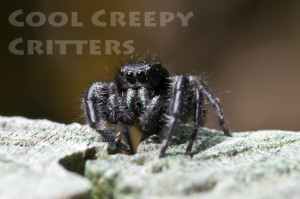
One feature all jumping spiders is that two of their eyes (Spiders have more than two) are very oversized. This gives jumping spiders a cuteness quality that is not always observed in others spider species. Of course these eyes serve a purpose helping the spider track and ambush its prey. Some Jumping spiders such as the Portia jumping spider (who feeds on other spiders) are observed carefully examining their environment to plan their attacks.
Jumping spider are truly fascinating predators of the garden and there are no shortages of shapes and sizes of them to observe.
Jumping Spider Sight and Curiosity
Jumping spiders are amazing in so many ways, but one thing I always love about them is their seemingly inquisitive behaviour. This little jumping spider seemed every bit as interested in me as I was in him. It followed my every move with his large eyes and motioned left to right with the movements of my camera. There is something undeniably cute about these fearsome tiny garden predators.
It can be pretty amazing to see these little spiders follow and track your hand as you move it along in front of them. Their vision is truly something amazing being able to look up as watch movement several feet away. Of course all this visual ability is for a reason, one probably not so cute to the prey that ends up on the other end of it. Jumping spiders use this vision to not only locate prey, but calculate distances. In at least one example the Portia jumping spider can formulate tactics to capture and consume other formidable spiders.
Cellar Spider VS Jumping Spider Interaction
I had been noticing this jumping spider hunting near some cellar spiders. I have witnessed both these spiders take down other spiders in the past. Having witnessed these cellar spider VS jumping spider interactions before, they always had seemed to result in a stalemate. I came back later to find the jumping spider being wrapped up in the cellar spiders web. Whatever conflict had happened now seemed long finished and the cellar spider had its next meal. However, these jumping spiders are resilient, and this one was not about to let that happen.
After some time I noticed the jumping spiders leg start moving. It is hard to say if the wrapped arachnid had taken a bite or not but it seemed to suddenly spring to life. After it cut through the web it quickly escaped the situation. The jumping spider left the area soon after seemingly none the worse for the encounter although decided against round two.
Jumping Spiders and Cellar Spiders both Accomplished Spider Hunters
I was a little frustrated having missed the jumping spiders attack. I have witness jumping spiders pulling apart other spiders webs to get at them. They are obviously extremely formidable spiders in the arachnid world for other spiders to contend with. Likewise the delicate looking cellar spider is often underestimated but is a superbly established spider hunter itself. These I have witnessed capturing such large prey such as the Giant House Spider Eratigena atrica. Cellar Spiders use their long legs to throw large amounts of webbing over their opponents subduing the often stronger more powerful adversary. They then move in close to the leg or other area to inflict a bite and inject venom. Cellar Spiders are often considered a great benefit to people as although they consume a large amount of prey, they are completely docile to people.
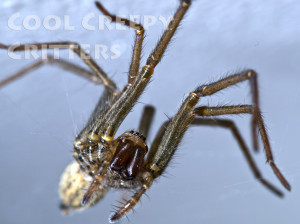
It was a lucky and amazing experience to witness these two top arachnid predators interacting like this, hopefully there will be more interactions to witness in the future.
Baby Garden Spider Nest Up Close
Ever see those little spider nests in the garden early in the summer? I found one on a deck chair and decided to do some close up shots of the little spiders to see what their world is like.
Crab Spider
These little guys are hard to spot. They camouflage in with the flowers they stalk in. Ambush predators, they get their name from their oversize front legs. I managed to get a few shots of this subject on a while daisy before he went back under the petal to wait for an unsuspecting insect.
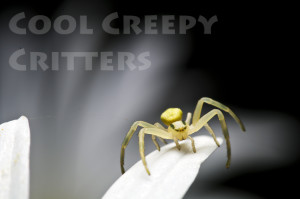
Woodlouse Spider
I discovered this little guy under some pots in my garden. This photo is several years old and I cannot remember what equipment I used to take the photo, but I did manage this picture of it emerging from what seems to be some kind of cocoon. What was immediately apparent on this spider was its bright colours and large over sized fangs. Upon doing some research I believe this is a Woodlouse Spider. It lives a life hidden under shelter and uses it’s large fangs to feed on woodlouse. It is a harmless spider although it can bite if handled which is apparently less painful than a bee sting and its venom is not dangerous. I put the planter back for it and carefully guided it back into its home after I was done with the picture.
Red Back Jumping Spider Vs Caterpillar
This struggle was over by the time I happened on it. I had never seen a redback Jumping spider attack a caterpillar before. The caterpillar was substantially bigger than the spider, and must have been a bit of a struggle. I was careful not to interrupt the spider while feeding since it was on a ledge and I did not want it to lose it’s hard won meal.
Sometimes I am thankful these things are small

